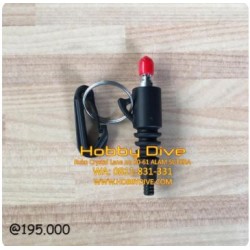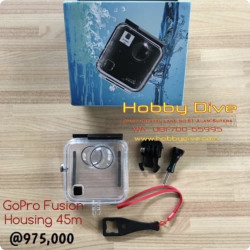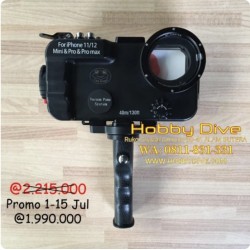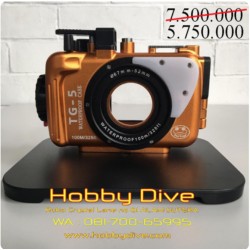No products
[HD-260] Sea frogs Seafrogs Vacuum Pump Leak Check System Underwater Housing
New product
[HD-260] Sea frogs Seafrogs Vacuum Pump System Underwater Housing
More info
Sea frogs Seafrogs Vacuum Pump System Underwater Housing
The Sea Frogs VPS-100 is the world´s simplest and most affordable compact pre-dive vacuum leak detector, simple user installation, no external parts.
Main features :
For only a fraction of the price of other similar systems, you too can now have a the new Sea Frogs VPS-100 pre-dive vacuum leak detector that will eliminate guesswork about the housing tightness and let you concentrate on the photography, instead of worrying if today is maybe your turn to experience the underwater photographer´s worst nightmare.
The Sea Frogs VPS-100 features a calibrated pressure sensor and processor.
The complete electronic circuit and the battery are located in the robust anodized aluminum one-way valve body for even more convenient operation and ease of installation.
The green/red LEDs are visible through the transparent acrylic circular window.
The included hand vacuum pump is lightweight and requires no batteries, so no nasty surprises when you are far from coast.
It achieves required under-pressure in average housing almost effortlessly.
The installation is simple and straightforward, just screwing the detector into the accessory port.
You can check the water tightness immediately after installation, making the process risk-free.
The circuit is self-calibrating, and as such suitable for altitude diving.
What´s included :
VPS-100 vacuum leak detector.
M16 Adaptor.
VP-100 hand vacuum pump.
Screwdriver.
CR2032 installed button battery.
CR2032 spare button battery.
Spares O-rings.
Compatible models of underwater camera housings:
- Sony A6xxx series Salted Line 60M/195FT Underwater camera housing
- Sony A7 II NG Series 40M/130FT Underwater camera housing
- Sony A7 III 40M/130FT Underwater camera housing
- Sony A7R III 40M/130FT Underwater camera housing
- Sony A9 40M/130FT Underwater camera housing
- Panasonic Lumix GH5 & GH5 S 40m/130ft Underwater Camera Housing
- Olympus TG-3 & TG-4 60m/195ft SeaFrogs Underwater Camera Housing
- Olympus TG-5 60m/195ft SeaFrogs Underwater Camera Housing
- Fujifilm X-T2 40M/130FT Underwater camera housing
- Canon G1X III 40m/130ft SeaFrogs Underwater Camera Housing
The vacuum pump system is used for checking the watertightness of underwater camera housing before submerging.
Install the camera inside underwater camera housing in dry and low humidity level place.
15-30 minutes before your dive remove the lid from back plate to access vacuum pump system opening (Illustration 1) and make sure the O-ring stays in place. Attach vacuum pump system to the opening by screwing it clockwise (Illustration 2). Unscrew the lid of electronic valve (Illustration 3) and press the button to turn on LED inside the valve (Illustration 4). Attach the rubber part of a pump to valve and start pumping air out (Illustration 5). Red LED starts blinking, indicating ambient atmospheric pressure. The hand pump is fitted to the threaded valve body and the air is pumped out of a unit until the red LED changes to green LED and add couple more strokes to make sure the sufficient underpressure. The additional stroke or two ensures that the valve is not on the edge of threshold. The pump is then removed, and the protective cap replaced to ensure airtightness. Observe the green LED blinking for 15 minutes to make sure there is no air leakage. Unscrew the lid of a valve to access the button and press it for a few seconds to release the pressure from inside and turn the valve LED off (Illustration 4). Remove the valve from back plate and place vacuum opening lid to its original place, make sure the O-ring is still there (Illustration 1). - safe to dive!
11 other products in the same category:
Customers who bought this product also bought:
-
![[HD-507] DIVING STICKER Waterproof Hang Loose Scuba Diving Accessories](https://www.toko-selam.com/shop/4555-home_default/-hd-507-diving-sticker-waterproof-hang-loose-scuba-diving-accessories.jpg)
[HD-507]...
[HD-507] DIVING STICKER Waterproof Hang Loose
Rp 15.000
-
![[P-133] Nobel Laminasi Sticker Diver](https://www.toko-selam.com/shop/4303-home_default/-p-133-nobel-laminasi-sticker-diver.jpg)
[P-133]...
[P-133] Nobel Laminasi Sticker Diver
Rp 20.000
-
![[HD-325] DIVING STICKER Waterproof Hang Loose 14cm Scuba Diving Accessories](https://www.toko-selam.com/shop/4556-home_default/-hd-325-diving-sticker-waterproof-hang-loose-14cm-scuba-diving-accessories.jpg)
[HD-325]...
[HD-325] DIVING STICKER Waterproof Hang Loose...
Rp 25.000
-
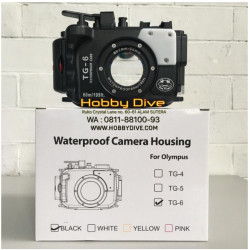
Olympus TG-6...
Olympus TG-6 Housing Sea Frogs HD-260 Black -...
Rp 2.690.000
-
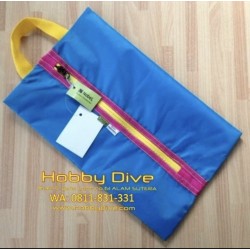
Nobel Shoe /...
Nobel Shoe / Sandal Bag P-201
Rp 40.000
-
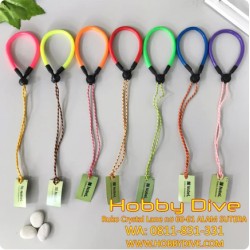
Nobel Hand...
Nobel Hand Wrist Lanyard Rope P-006
Rp 30.000

![[HD-260] Sea frogs Seafrogs Vacuum Pump System Underwater Housing [HD-260] Sea frogs Seafrogs Vacuum Pump System Underwater Housing](https://www.toko-selam.com/shop/4040-large_default/-hd-260-sea-frogs-seafrogs-vacuum-pump-system-underwater-housing.jpg)
![[HD-260] Sea frogs Seafrogs Vacuum Pump System Underwater Housing [HD-260] Sea frogs Seafrogs Vacuum Pump System Underwater Housing](https://www.toko-selam.com/shop/4040-cart_default/-hd-260-sea-frogs-seafrogs-vacuum-pump-system-underwater-housing.jpg)
![[HD-260] Sea frogs Seafrogs Vacuum Pump System Underwater Housing [HD-260] Sea frogs Seafrogs Vacuum Pump System Underwater Housing](https://www.toko-selam.com/shop/4041-cart_default/-hd-260-sea-frogs-seafrogs-vacuum-pump-system-underwater-housing.jpg)
![[HD-260] Sea frogs Seafrogs Vacuum Pump System Underwater Housing [HD-260] Sea frogs Seafrogs Vacuum Pump System Underwater Housing](https://www.toko-selam.com/shop/4042-cart_default/-hd-260-sea-frogs-seafrogs-vacuum-pump-system-underwater-housing.jpg)
![[HD-260] Sea frogs Seafrogs Vacuum Pump Leak Check System Underwater Housing](https://www.toko-selam.com/shop/4040-home_default/-hd-260-sea-frogs-seafrogs-vacuum-pump-system-underwater-housing.jpg)

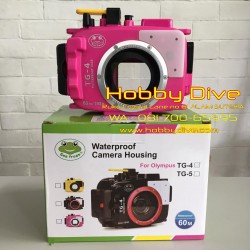
![[HD-167] Olympus TG-5 Housing Sea Frogs](https://www.toko-selam.com/shop/3903-home_default/-hd-167-olympus-tg-5-housing-sea-frogs.jpg)
![[HD-257] Underwater Housing Mobile Phone iPhone 6 / 7/ 8 / X](https://www.toko-selam.com/shop/4027-home_default/-hd-257-underwater-housing-mobile-phone-iphone-6-7-8-x.jpg)
![[HD-258] Underwater Housing Mobile Phone iPhone 6 / 7/ 8 Plus](https://www.toko-selam.com/shop/4032-home_default/-hd-258-underwater-housing-mobile-phone-iphone-6-7-8-plus.jpg)
![[HD-259] Underwater Diving General Mobile Phone](https://www.toko-selam.com/shop/7634-home_default/-hd-259-underwater-diving-general-mobile-phone.jpg)
